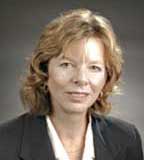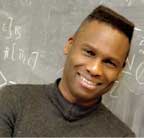 Cherry A. Murray  Philip W. Phillips |
APS members have elected Cherry A. Murray, deputy director for science and technology at Lawrence Livermore National Laboratory, as the Society's next vice president. Murray will assume the office of vice president in January 2007. Arthur Bienenstock of Stanford University will become president-elect, and Leo Kadanoff, professor emeritus at the University of Chicago, will serve as APS president for 2007, succeeding 2006 APS President John Hopfield of Princeton University.
In other election results, Philip Phillips, a professor of physics at the University of Illinois at Urbana-Champaign, was selected as the new vice-chair of the APS Nominating Committee, which has the responsibility of selecting a slate of candidates each year to run for APS office. Robert Austin, a professor of physics at Princeton University , and Elizabeth J. Beise, a professor of physics at the University of Maryland , were elected as general councilors.
Murray is an experimental condensed matter physicist who has worked in surface and low temperature physics, light scattering and phase transitions in complex fluids. She received her PhD in physics in 1978 from MIT. She first joined Bell Labs in 1978 as a member of the technical staff. She held a number of management positions over the years, including department head for low temperature physics, department head for condensed matter physics, department head for semiconductor physics, and director of Bell Lab's Physical Research Lab.
In 2000, Murray became vice president for physical sciences and then senior vice president in 2001. Discover Magazine named her one of the “50 Most Important Women in Science” in 2002. She has served on the APS Executive Board and Council, and has been an active member of many APS task forces, divisions, and forums. In 1989, Murray won the APS Maria Goeppert Mayer award, and in 2005, the APS George E. Pake Prize.
In her candidate's statement Murray said “I prefer to think of physics as an inclusive rather than an exclusive field. I believe that it is important for APS to promote a broad definition of physics.”
She credits her work experience at Bell Labs with fostering an appreciation for “the importance of linking interdisciplinary science and engineering to create impact for society.” She pledged to promote increased federal funding for all science, mathematics and engineering teaching and research. “In order for the US to compete effectively, we must work hard to stay in the technology lead in a few key areas,” she said.
Murray also called for the APS to promote the US as a site for a future major physics facility, such as the proposed International Linear Collider. “ US science and technology is greatly enhanced by being part of the global science and engineering enterprise,” she said.
A theoretical condensed matter physicist, Phillips studies quantum phase transitions and strongly correlated electrons. Phillips is a past recipient of the APS Edward A. Bouchet Award. He was an APS general councilor and a member of the Executive Board. He also served on the APS Committee on Committees. Phillips received his PhD from the University of Washington in 1982. He joined the faculty at MIT before coming to the University of Illinois in 1993.
An important and perhaps overlooked role of APS committees is to provide a training ground for the Society's future leaders,” Phillips said in his candidate's statement. “I believe that it is important to involve not only established stars in committee work, but to provide opportunities for professional growth and development for the next generation of our nation's science leaders.”
Austin received his PhD in physics from the University of Illinois Champaign-Urbana in 1976. He did a postdoc at the Max Planck Institute for Biophysical Chemistry from 1976-1979 and has been at Princeton University since 1979. He has chaired the APS Division of Biological Physics. He received the 2005 APS Edgar Lilienfeld Prize. He has a wide-ranging set of interests in the field of biological physics. Recently he worked on high resolution multimode imaging of biological objects using new nanocrystal materials.
In his candidate's statement, Austin emphasized the importance of reaching out to other scientific fields. “I also believe that it is absolutely critical in the 21st century that physics not look back complacently at its enormous successes but instead reach out to other disciplines, in particular biology, that are exploding in their growth, for their successes surely have had their foundations laid by physicists and they will need the continued close connection with physicists and our approaches to problem solving to thrive,” he said.
Beise received her PhD in physics from the MIT in 1988. She worked as a Research Fellow in the Kellogg Laboratory at Caltech prior to coming to the University of Maryland as an assistant professor in 1992. Since then, her research has focused on the use of electron scattering to study aspects of nucleon structure and light nuclear systems. In 1998 she received the APS Maria Goeppert-Mayer award. Beise has served on the APS Division of Nuclear Physics executive, program, and nominating committees, and on the APS Committee on the Status of Women in Physics.
In her candidate's statement, Beise identified several areas of longstanding concern for the APS, including improving visa access for international scientists, communicating with Congress and with the public about the science opportunities ahead, and working towards balancing the demographics of the physics community. “The physics community has an important and necessary role in providing scientific leadership for the nation.” she said.
©1995 - 2024, AMERICAN PHYSICAL SOCIETY
APS encourages the redistribution of the materials included in this newspaper provided that attribution to the source is noted and the materials are not truncated or changed.
Contributing Editor: Jennifer Ouellette
Staff Writer: Ernie Tretkoff
October 2006 (Volume 15, Number 9)
Articles in this Issue

